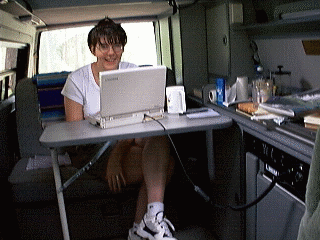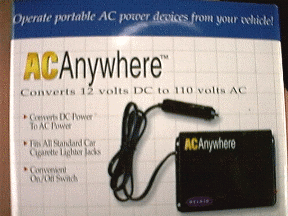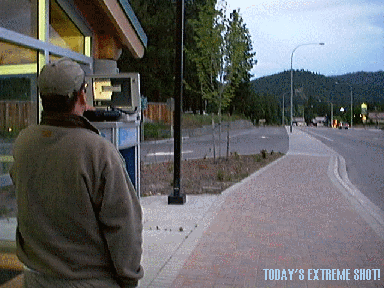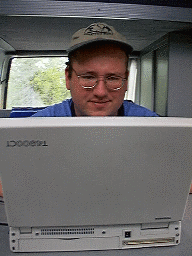
![]()
More than just some glorified flophouse on wheels, Otto was also the technological backbone that supported our telecommuting efforts. As equipped by the good people at Winnebago who did the camper conversion, Otto provided a solid foundation on which to build an efficient, modern office. There was a desk (ok, a table), plenty of power outlets, and lots of cabinetry. Like I said, a foundation. This page describes what we carried and used in Otto to build on that foundation, turning Otto into the roving telecenter that we needed for the Odyssey.
![]()
As a technical writer, the guts of my office is the computer. Since portability is pretty much the essence of the Extreme Telecommuting experience, we opted for a laptop. Specifically, we used a Toshiba T4900CT laptop based on an Intel Pentium processor running at 90Mhz. It sported a 1GB hard drive, 40MB of RAM, and an internal modem with a top speed of 33.6 kbps. This package worked well for our needs, though we could have used a slightly bigger hard drive. All those digital pictures started to take up a lot of space towards the end of month two.
There was no particular reason we chose this brand -- it just happened to be the type of laptop with which my employer provided me. It held up well, never causing us any trouble. We did fry one modem, but were able to pick up a new one without any problems. We also carried an external CD-ROM drive, but never had need for it.
| We also carried a 12V adapter for the laptop. This let the computer run off a cigarette-lighter style plug. Since Otto features three different outlets of this sort, this was an indispensable thing to carry. It let us charge the laptop's batteries while under way and work without draining the batteries. You can see it in the picture there at the right, running from just above the fridge to the back of the laptop. Incidentally, that's the standard Otto Van Office layout -- sitting on the back bench seat with the table out in front of you, laptop running off the 12V, and a giddy smile on your face. |  |
Email is great -- I love it. Sometimes, though, you do need to talk to somebody. That's why we carried a cellular phone. We carried a cheap Audiovox analog cell phone. It also had a 12V adapter so that it could run off the cigarette lighter.
In general, the cell phone worked much better than anticipated. I figured we'd almost never be within coverage zones, trekking about in the boonies as we would be. As it turned out, coverage was actually pretty good, regardless of where we were. In fact, if you're on an interstate corridor, you're pretty much covered, regardless of the location. Of course, there are exceptions to this (West Texas comes to mind), but that's why we had voicemail.
One annoyance with national cell phone coverage -- a few independent owners of cellular systems around the nation have not yet struck "reciprocal billing" agreements with the big carriers (GTE, AT&T). This means that in order to make a call originating with their cells you need to give them a credit card number. Since we were using an analog cell phone, we didn't want to do that (scanners can pick up analog cell conversations), so we just suffered until we got to a payphone. Utah is the best (or worst, depending on your point of view) example of this -- the company that owns the cells there has not yet struck a reciprocal billing agreement with the big carriers. You just get some incredibly smarmy voice repeating endlessly, "Your call cannot be completed. Message six. Message six."
One thing we didn't do was carry a calling card. This was a huge mistake. We ended up buying those overpriced prepaid calling cards you can get at 7-11 or the post office. Realizing our mistake about two weeks in, we tried to get a calling card. For reasons beyond my ken (and my barbie, too), it's actually surprisingly hard to get a calling card without having a phone in a house. We gave up and stuck with the prepaid calling cards, somewhat to our chagrin.
As you might have guessed, we did a little roaming outside our local coverage area. In fact, we got so used to seeing the "Roam" light blink on our phone that when we finally got back, we momentarily wondered why we were unable to turn our phone on anymore. Why wouldn't that dang "Roam" light light? We eventually figured it out, intellectual titans that we are. Roaming, by the way, adds up quickly. While it's pretty darn neat to take a call from work while driving down Bourbon Street, keep in mind that the meter's running. Our monthly cellular bill ran about $150.
The source for all the pictures used in this website is a Fuji DS-7 digital camera. We liked the camera a lot -- you can judge the results for yourself by checking out the pictures in the site. It has a little memory card inside that stores recorded pictures -- up to about 24 in the large format (640x480 pixels). Once the memory card is full, you can download your pictures to a computer before deleting them from the memory card. Then, you're ready to shoot some more. The only tiny downer about the digital camera is that we might have been happier with a little extra space on the memory card. Sometimes, we didn't get to downloading the pictures for a couple days and found ourselves bumping our heads against the 24 picture ceiling. That's when you agonize over which picture to delete so you can fit just one more Extreme Shot of the Day on to the card. It's a small price to pay for the ability to get web-quality images onto the computer almost instantly. Digital cameras are a lot of fun.
![]()
All this gear is pretty cool, but it wouldn't have done us much good if we hadn't been able to power it up with a little bit of that good old electricity. Juice. Power. Now, as you regular readers out there no doubt know, Otto provides us with a whole panoply of power options. There are three (count 'em, three) different 12V cigarette lighter-style plugs scattered throughout the cabin -- one in the rear, one in the middle, and one in the front. The back two run off the coach (deep-cycle) battery and are active so long as the coach battery retains a charge. The front one runs off the car battery. In addition to these outlets, there are also two different 110V outlets, each sporting a pair of plugs -- one in the back and one above the refrigerator. These, however, are only active if the van is plugged into a shoreline -- something we almost never did, preferring to stay in more rustic accomodations whenever possible.
So, what did we do to take advantage of all these different power sources? Well, we had adapters. Lots of adapters. A 12V adapter for the phone. A 12V adapter for the laptop. We really wanted a 12V fan, but never got one. And, finally, we also had the AC Anywhere power inverter. This let us get 110V electricity from out 12V outlets. The two pictures below show how this works. That's our battery-charger charging batteries, using 110V power adapted from the 12V outlet using the AC Anywhere adapter. And, yes, it did take this liberal arts major about two hours to figure that out.
 |
 |
Power was never a problem for us. We've seen some folks who have installed solar panels on their vehicles to increase their power stores. We never found ourselves needing extra power, so this wouldn't have helped us. The caveat to that is that we moved a lot, and when you're moving, the engine is constantly charging the coach battery. Maybe if we had stayed in one place for a long time (more than three days, say), we could have used solar panels, but as it was, we did fine without them.
![]()
 |
Well, even Extreme Telecommuters have to pay the bills. And to pay the bills, you've got to get the bills. And the bills come in the mail. How do you get mail in a van, though? General Delivery, my friend. It's all in the General Delivery. General Delivery mail is a really neat feature of the U.S.P.S. designed to accomodate folks who are moving into an area but don't have an address yet. That's its stated purpose, but it works great for travellers, too. You just specify that your mail be delivered "General Delivery" to a specific zip code, and they will hold it for you at that zip code's post office. It's really pretty handy. We used my parents' address as our address and had them send us a biweekly mail drop at a post office along our route. It worked just great. If you don't have parents, or if you have parents but they don't like you, or maybe if you were just born of immaculate conception and raised by jackals, there are plenty of "Pack & Send" types of places out there that will do the mail-forwarding thing for you. Hit the yellow pages and pick your pals. That's Kristanne at left, getting our General Delivery mail in Bozeman, Montana. Looks easy, huh? Keep in mind, though, that Kristanne is a seasoned professional. Your mileage may vary. |
![]()
Telecommuting by definition requires a network. Usually that network consists of the phone line in your house connected to your computer, dialing out somewhere into the ether. What happens, though, when you take away the house? The fixed phone connection? How do you get onto the network then?
| The answers to that question provided some of the most memorable (and Extreme) moments of the Odyssey. With the overblown expectations we heaped on the Acoustical Koupler collapsing around our heads, we were forced to seek our network access elsewhere. We had pictured rosy landscapes with a payphone in the middle of nowhere, our laptop happily connected, merrily transferring its bits and bytes away, but that was not to be. Well, it was to be exactly once, on the first day of the trip, pictured at right. After that though, we had to resort to hijacking phone lines wherever we could find them. In Holiday Inns. In libraries. And, most frequently, in Kinko's. We became cunning experts at preying on the unsuspecting masses, dropping behind a counter and plugging into a phone jack for a quick email fix wherever we could find it. As you read the Odyssey's pages, you'll get a flavor for what it's like to live this way, never sure where your next score is going to come from. It's edgy, it's enervating, and it's positively Extreme. Well, in a sort of geeky, nebbish kinda way, but Extreme, nonetheless! | 
|
As for the mundanities of what we used for net access...well, Netcom hosted (and hosts) this Web page. They did an OK job, but I don't have any real comparison points for reliability or customer service. Pricewise, they were more than competitive. As for reliability, well... The Internet is in flux right now. If companies in other industries (say, television makers) demonstrated the same level of reliability considered acceptable for Internet Service Providers, there would be an awful lot of screaming customers out there and Ralph Nader would be in an apoplectic tizzy that would last at least until Fleetwood Mac breaks up again. But what can you say? The internet was not designed to support the kind of load it is receiving. It was just supposed to be a nice little network for the military, not the dawning of the freaking information age. The telephone infrastructure in place for the internet is being overwhelmed by customer demand. Even the protocols in place to run the internet (TCP/IP) are rapidly becoming obsolete (we're running out of IP addresses). So, some fuzziness and some annoying episodes are just par for the Internet course. Not that this stopped me from cursing uncontrollably when I couldn't connect to my own site, or anything. I may understand the problem a little bit, but it still ticks me off.
I also used Netcom for my internet access (separate from web hosting). I've been with them for a long time, and they're competitive with the big boys, and have about the same number of dial-in lines. Usually, though, I'd use their 1-800 dial-in number so I could use phones that wouldn't let me dial long distance (like in Kinko's, or a hotel lobby).
I wrote the web pages in MS-Notepad (basic text editor), manipulated the images using Paint Shop Pro, FTP'd with WS-FTP, read mail with Pegasus, browsed the web with Netscape, and read news with Free Agent. I made the GIF animations using GIF Construction Set. I missed Quake. Here endeth the Geek Recital.
![]()
This was a surprisingly common question dogging the Odyssey. Did I ever actually work? The simple answer is Yes. You bet your sweet bippy. I wrote help files. Participated in teleconferences. Answered the questions of coworkers (and yes, it is pretty cool when you can answer the question of someone in Menlo Park, California on a cell phone while sitting on a beach in Florida's panhandle). I wrote the beta draft of an operations manual for a network management console. I even had a successful performance review. All while traveling around the country in a Eurovan with my fiancee. So, yes, I did work. And yes, it can be done.
 |
The key to success in an Extreme Telecommuting relationship is flexibility. You have to take your office where you find it. If it's in the van, that's great. On your future brother and sister-in-law's floor, that's wonderful. In a Kinko's, in a cafe, in a hotel, in the middle of the Black Hills Classic Motorcycle Rally...it's all good. Oh, yeah, and this too (and this is key) -- you need to be able to type without getting nauseous while a car is moving. Either that or buy a couple bushels of dramamine. Because you're not going to make it through three months, 22,000 miles, 36 states, two provinces, and your job without doing a little typing while underway. |
Flexibility is key to both sides of the telecommuting relationship. You need to be flexible enough to get your job done whenever you have the opportunity while still making all your deadlines with good work. Your manager needs to be flexible enough to accept that you're not always in the same place. So long as the manager is confident in your ability to produce quality on-time work and trusts your commitment to do so, there should be no problem. Just remember -- don't abuse the trust! Once gone, it's not easily replaced, and that's when you find yourself scanning the want ads. Or so I hear, anyway.
And that's the long and short of it. As you can tell, Otto worked pretty darn well as an office. You might also want to read about how Otto worked out as our home. There, you'll see action-packed glossies and hard-hitting reviews of all the home appliances that accompanied us on the Office Odyssey. Hoooo-boy! Bring the head-cheese and slivovitz!